Rain of animals
A rain of animals is a rare meteorological phenomenon in which flightless animals fall from the sky. Such occurrences have been reported in many countries throughout history.[1] One hypothesis is that tornadic waterspouts sometimes pick up creatures such as fish or frogs, and carry them for up to several kilometres.[1][2] However, this aspect of the phenomenon has never been witnessed by scientists.[3] It is now accepted that there is only co-incidental association between animals perceived to be falling from the sky and meteorological or earthquake-related phenomena.[4]
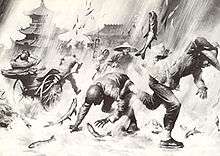
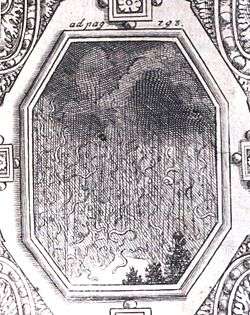
History
Rain of flightless animals and things has been reported throughout history.[1] In the first century AD, Roman naturalist Pliny The Elder documented storms of frogs and fish.[5] In 1794, French soldiers saw toads fall from the sky during heavy rain at Lalain, near the French city of Lille.[6] Rural inhabitants in Yoro, Honduras claim 'fish rain' happens there every summer, a phenomenon they call Lluvia de Peces.[7]
Explanations
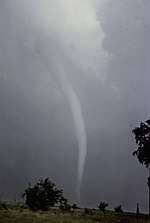
French physicist André-Marie Ampère (1775 – 1836) was among the first scientists to take seriously accounts of raining animals. Addressing the Society of Natural Sciences, Ampère suggested that at times frogs and toads roam the countryside in large numbers, and that violent winds could pick them up and carry them great distances.[3]
After a reported rain of fish in Singapore in 1861, French naturalist Francis de Laporte de Castelnau speculated that a migration of walking catfish had taken place, dragging themselves over land from one puddle to another, following the rain.[8]
The likeliest explanation for many of the supposed cases is that there is no falling happening at all and the animals are driven along by winds or a deluge of some sort.[9] This explanation also accounts for the prevalence of reports that only a single species or type of animal is ever reported raining from the sky.
A current scientific hypothesis involves tornadic waterspouts: a tornado that forms over the water.[1][10][11][12] Under this hypothesis, a tornadic waterspout transports animals to relatively high altitudes, carrying them over large distances. This hypothesis appears supported by the type of animals in these rains: small and light, usually aquatic,[13] and by the suggestion that the rain of animals is often preceded by a storm. However, the theory does not account for how all the animals involved in each individual incident would be from only one species, and not a group of similarly-sized animals from a single area.[14] Further, the theory also does not account for a genuine tornadic waterspout not actually sucking objects up and carrying them rather than flinging objects out to the sides.[4]
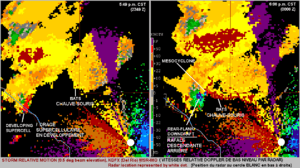
In the case of birds, storms may overcome a flock in flight, especially in times of migration. The image to the right shows an example wherein a group of bats is overtaken by a thunderstorm.[15] In the image, the bats are in the red zone, which corresponds to winds moving away from the radar station, and enter into a mesocyclone associated with a tornado (in green). These events may occur easily with birds, which can get killed in flight, or stunned and then fall (unlike flightless creatures, which first have to be lifted into the air by an outside force). Sometimes this happens in large groups, for instance, the blackbirds falling from the sky in Beebe, Arkansas, United States on December 31, 2010.[16] It is common for birds to become disoriented (for example, because of bad weather or fireworks) and collide with objects such as trees or buildings, killing them or stunning them into falling to their death. The number of blackbirds killed in Beebe is not spectacular considering the size of their congregations, which can be in the millions.[17] The event in Beebe, however, captured the imagination and led to more reports in the media of birds falling from the sky across the globe, such as in Sweden and Italy,[18] though many scientists claim such mass deaths are common occurrences but usually go unnoticed.[19] In contrast, it is harder to find a plausible explanation for rains of terrestrial animals.
Occurrences
The following list is a selection of examples.
Fish
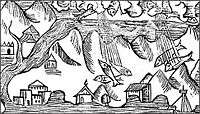
- Kanchanpur, Nepal
- Singapore, February 22, 1861[20]
- Madhesh, Nepal, May 15, 1900[21]
- Moose Jaw, Saskatchewan, Canada, July 1, 1903[22]
- Marksville, Louisiana, October 23, 1947[23]
- Ilorin, Kwara State Nigeria, May 19, 1993
- Knighton, Powys, Wales, 18 August 2004.[24]
- Kerala State, India, February 12, 2008[25]
- Bhanwad, Jamnagar, India, October 24, 2009[26]
- Lajamanu, Northern Territory, Australia, February 25 and 26, 2010,[27]
- Loreto, Agusan del Sur, Philippines, January 13, 2012[28][29]
- IIT Madras, Chennai, Tamil Nadu, India September 12, 2013[30]
- The annual Lluvia de Peces in Yoro, Honduras
- Chilaw, Sri Lanka, 6 May 2014[31]
- Nandigama, Andhra Pradesh India, 19 June 2015,[32]
- Guntur, Andhra Pradesh India, 16 August 2015[33]
- Dire Dawa, Ethiopia, 20 January 2016[34]
- Pathapatnam, Srikakulam district, Andhra Pradesh, 19 May 2016[35]
- Philadelphia, Pennsylvania, 9 September 2016[36]
- Mexico, Tamaulipas, Tampico, 26 September 2017[37]
- Oroville, California, 16 May 2017[38]
- Jaffna, Sri Lanka, 7 November 2017[39]
Spiders
Frogs and toads
- Ishikawa Prefecture, Japan, June 2009 (occurrences reported throughout the month)[42]
- Rákóczifalva, Hungary, 18–20 June 2010 (twice)[43]
- Cabo Polonio, Uruguay, Since 2011 (twice)[44]
See also
References
- "Can it rain frogs, fish or other objects". Library of Congress. August 26, 2010.
- How can it rain fish? BBC News 20 August 2004.
- When It Rains Animals: The Science of True Weather Weirdness. Alasdair Wilkins. March 21, 2012.
- Dunning, Brian (September 8, 2009). "It's Raining Frogs and Fish". SKEPTOID.
- "How can it rain fish?". August 20, 2004 – via news.bbc.co.uk.
- Hasler, Joe. "Weird Stories of Objects Falling From the Sky - Explained". www.popularmechanics.com. Retrieved 31 October 2017.
- Rivas, Orsy Campos (November 7, 2004). "Lo que la lluvia regala a Yoro (discusses a rain of fishes that occurs annually in Honduras)". Hablemos.
- Comptes Rendus hebdomadaires des séances de l’Académie des sciences. 52. 1861. pp. 880–81.
- Nobel, Justin (2014-03-18). "When Animals Fall from the Sky". Modern Farmer. Retrieved 2019-07-10.
- Strange Rain: Why Fish, Frogs and Golf Balls Fall From the Skies. Sarah Zielinski, Smithsonian Magazine. 8 September 2015.
- What is animal rain phenomenon and how is it explained?. World Weather Online. 19 August 2014.
- When It Rains Animals: The Science of True Weather Weirdness. Alasdair Wilkins, iO9. 21 March 2012.
- Angwin, Richard (July 15, 2003). "Wiltshire weather". BBC.
- When Animals Rain From The Sky. Scribol.
- "Bat-eating Supercell". National Weather Service. March 19, 2006.
- "More than 1,000 blackbirds fall out of Arkansas sky". BBC News. 2 January 2011. Retrieved 2 January 2011.
- "Why Are Birds Falling From the Sky?". National Geographic. 6 January 2011. Retrieved 6 January 2011.
- "Now It's Dead Doves Falling From Sky in Italy". "AOL". 7 January 2011. Archived from the original on 9 January 2011. Retrieved 7 January 2011.
- "FACT CHECK: Mass bird, fish deaths occur regularly". "Associated Press". 7 January 2011. Retrieved 7 January 2011.
- McAtee, Waldo L. (May 1917). "Showers of Organic Matter" (PDF). Monthly Weather Review. 45 (5): 223. Bibcode:1917MWRv...45..217M. doi:10.1175/1520-0493(1917)45<217:soom>2.0.co;2. Retrieved 2009-01-26.
- "Rained Fish", AP report in the Lowell (Mass.) Sun, May 16, 1900, p4
- "Canada Day weather through the years", reported in The Weather Network : Archived 2012-06-30 at the Wayback Machine, June 27, 2012
- "Greg Forbes. Spooky Weather. The Weather Channel. Posted: October 27, 2005". Archived from the original on December 10, 2009.
- "BBC - Shropshire - Weird Shropshire - Fish shower". www.bbc.co.uk.
- "Fish rain takes Kerala villagers by surprise". The Financial Express. February 14, 2008.
- "Fish Rain", reported in the India : , October 24, 2009
- "It's raining fish in Northern Territory", reported in news.com.au : , February 28, 2010
- Lani Nami Buan (January 15, 2012). "It's raining fish! It's normal". GMA News. Retrieved January 16, 2012.
- Jereco O. Paloma (January 15, 2012). "Agusan's 'rain of fish' natural although unusual". SunStar Davao. Retrieved January 16, 2012.
- "Fish Rain", reported in the India : , September 12, 2013
- "Fish rain down on Sri Lanka village, reported in https://www.bbc.com/news/world-asia : , 6 May 2014
- https://www.youtube.com/watch?v=So3c2GSXYs0
- Villagers wake up to find fish in fields!, The Times of India, August 17, 2015
- "Fish rain in diredawa Ethiopia.", http://mereja.com/news/1080799
- "Fish rain in Srikakulam district, Andhra Pradesh"., One India Telugu, May 20, 2016
- "Catfish Falls From Sky and Strikes Woman in Face Near Art Museum, Philadelphia"., Philadelphia Enquirer, September 9, 2016
- "No lo has visto todo aún: llovieron peces en Tampico". Excélsior. September 27, 2017.
- "How 100 fish rained down on an Oroville school remains a mystery". KTVU FOX 2. June 23, 2017.
- "'Fish rain' falls on Sri Lankan village | The Star". www.thestar.com.my.
- Spiders Rain From Skies In Australian Town Of Goulburn, Huffington Post UK
- "Designer registra 'chuva de aranhas' em cidade do interior do Paraná". Globo.com. 8 February 2013. Retrieved 9 February 2013.
- Demetriou, Danielle (2009-06-10). "Sky 'rains tadpoles' over Japan". Telegraph.co.uk. Retrieved 2009-08-07.
- "Szemtanúk szerint békaeső hullott a településre". szoljon.hu. 2010-06-21. Retrieved 2010-06-21.
- "Cómo fue que viví una lluvia de ranas y sapos" [How it was that I experienced a rain of frogs and toads] (in Spanish). Archived from the original on 2017-04-04.
- Fort, Charles (1919). "Ch. 4". The Book of the Damned. sacred-texts.com. p. 48.
- "Worms Fall from the Sky in Jennings". WAFB Channel 9. 7 July 2007. Retrieved 12 December 2008.
- "青岛下"海鲜"?真实情况并不好笑". 时讯网. 14 May 2018. Retrieved 16 June 2018.
- It's raining octopus! Sea creatures fall from the sky after being 'sucked from the ocean by a waterspout and carried into coastal city' during powerful storm in China, dailymail.co.uk, 15 June 2018
Further reading
- Bajkov, A.D. Do fish fall from the sky? Science, v. 109, April 22, 1949: 402.
- Bourchier, Daniel. “It’s raining fish…no really.” Sunday Territorian, Australia, February 28, 2010.
- Branley, Franklyn M. It's raining cats and dogs: all kinds of weather and why we have it. Illustrated by True Kelley. Boston, Houghton Mifflin, 1987. 112 p. (Juvenile)
- Cerveny, Randall S. Freaks of the storm: from flying cows to stealing thunder, the world's strangest true weather stories. New York, Thunder's Mouth Press, c2006. 371 p.
- Chandler, Barb. Froggy weather. Weatherwise, v. 57, Jan./Feb. 2004: 42.
- Christian, Spencer and Antonia Felix. Can it really rain frogs?: the world's strangest weather events. New York, Wiley, 1997. 121 p. (Juvenile).
- Corliss, William. Tornados, dark days, anomalous precipitation, and related weather phenomena: a catalog of geophysical anomalies. Glen Arm, MD: Sourcebook Project, c1983. 196 p.
- Dennis, Jerry. It's raining frogs and fishes: four seasons of natural phenomena and oddities of the sky. New York, HarperCollins, c1992. 323 p.
- Englebert, Phillis. The complete weather resource. Detroit, UXL, c1997-2000. 4 v.
- “Frogs fall from the sky.” Herald Sun, Melbourne, Australia, June 8, 2005. p. 2.
- Gray, J. E. The shower of fishes. Zoologist; a monthly journal of natural history, v. 17, 1859: 6540-41
- Gudger, E. W. Do fish fall from the sky with rain? Scientific Monthly, v. 29, December 1929: 523-527.
- McAtee, Waldo L. Showers of organic matter. Monthly Weather Review, v. 45, May 1917: 217-224. (PDF).
- Posey, Carl A. The living earth book of wind and weather. Pleasantville, NY, Reader's Digest Association, c1994. 224 p.
- Waterspouts. In McGraw-Hill concise encyclopedia of science and technology. 5th edition. New York, McGraw-Hill, c2005. p. 2369-2370.
External links
| Wikimedia Commons has media related to Raining animals. |
- Raining cats and dogs
- Mysterious Falls from the Sky. A review on the American perspective.
- 10 Craziest Things To Fall From the Sky